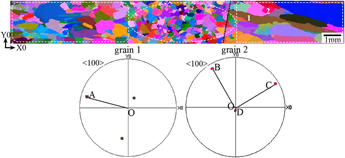Crossref Citations
This article has been cited by the following publications. This list is generated based on data provided by
Crossref.
Sun, K.M.
Li, L.
Chen, S.D.
Xu, G.M.
Chen, G.
Misra, R.D.K.
and
Zhang, G.
2017.
A new approach to control centerline macrosegregation in Al-Mg-Si alloys during twin roll continuous casting.
Materials Letters,
Vol. 190,
Issue. ,
p.
205.
Li, Lei
Ban, Chunyan
Shi, Xuchen
Zhang, Haitao
Zuo, Yubo
Zhu, Qingfeng
Wang, Xiangjie
Zhang, Hui
Cui, Jianzhong
and
Nagaumi, Hiromi
2017.
Effects of a high magnetic field on the primary zinc-rich crystals in hypoeutectic Zn-Sn alloy.
Journal of Crystal Growth,
Vol. 463,
Issue. ,
p.
59.
Li, Lei
Zhu, Qingfeng
and
Cui, Jianzhong
2017.
Electromagnetic Field Induced Structure Transition of Aluminum Alloys during Direct Chill Casting.
MATERIALS TRANSACTIONS,
Vol. 58,
Issue. 8,
p.
1134.
Li, Lei
Ban, Chunyan
Bi, Yuantong
Zhang, Ruixue
Zhang, Haitao
Liu, Tie
Zhu, Qingfeng
Zuo, Yubo
Wang, Xiangjie
and
Cui, Jianzhong
2018.
A crystallographic study on the growth of Laves phase MgZn2 during the solidification process of Zn–Mg alloy under a high magnetic field.
Journal of Materials Science,
Vol. 53,
Issue. 21,
p.
15181.
Li, Lei
Zhu, Qingfeng
Zuo, Yubo
and
Cui, Jianzhong
2020.
Study on the transitional structures of 7075 aluminum alloy ingot after switching off a low-frequency electromagnetic field in the horizontal direct chill casting.
Journal of Crystal Growth,
Vol. 548,
Issue. ,
p.
125827.
Zou, Yongshun
Huang, Ao
Wang, Runfeng
Fu, Lvping
Gu, Huazhi
and
Li, Guangqiang
2020.
Slag corrosion-resistance mechanism of lightweight magnesia-based refractories under a static magnetic field.
Corrosion Science,
Vol. 167,
Issue. ,
p.
108517.
Luo, Yajun
Wu, Zhenggang
Zhou, Li
He, Min
Zhang, Zhenlin
Peng, Xiaomin
and
Zhang, Zhifeng
2020.
Effect of Electromagnetic Stirring Position on Uniform Direct Chill Casting of Large-Sized 7005 Alloy Billet.
JOM,
Vol. 72,
Issue. 12,
p.
4665.
Zhou, Li
Luo, Yajun
Zhang, Zhenlin
He, Min
Xu, Yinao
Zhao, Yulei
Liu, Sheng
Dong, Lijun
and
Zhang, Zhifeng
2021.
Microstructures and Macrosegregation of Al–Zn–Mg–Cu Alloy Billet Prepared by Uniform Direct Chill Casting.
Materials,
Vol. 14,
Issue. 4,
p.
708.
